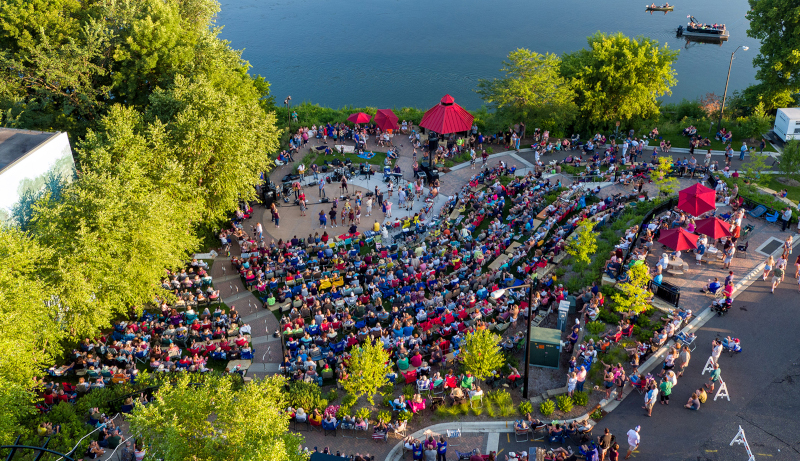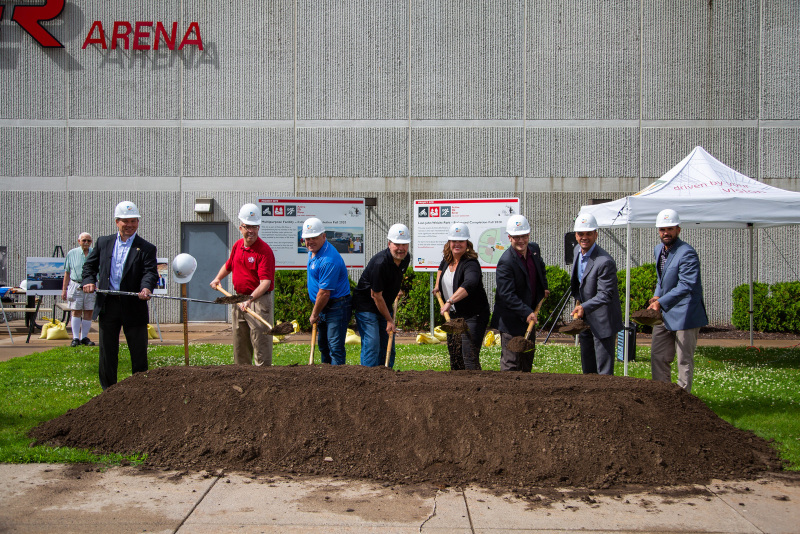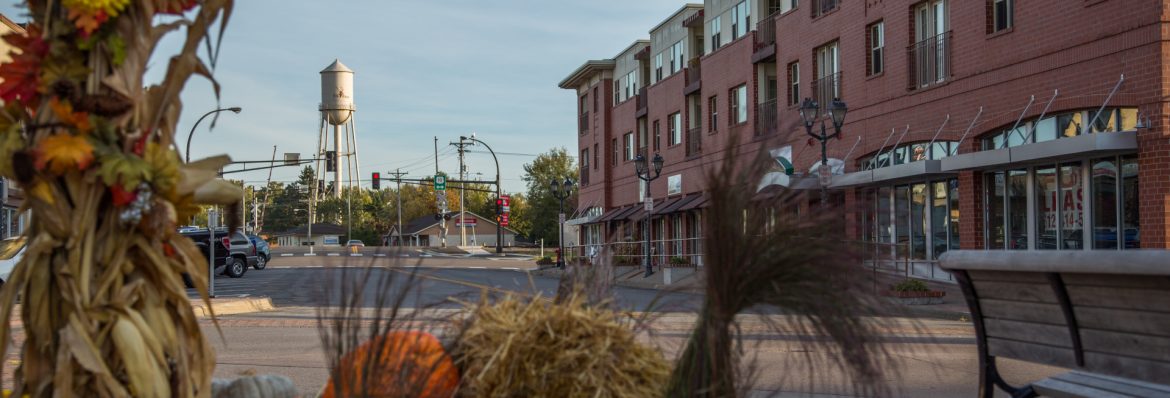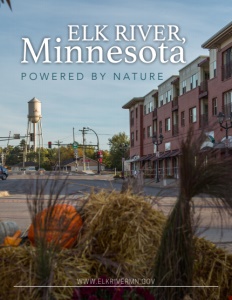Elk River, Minnesota
Powered by nature
Business View Magazine interviews Calvin Portner, City Administrator of Elk River, Minnesota, as part of our focus on economic development in American cities.
Elk River is a city in Sherburne County, Minnesota, situated at the confluence of the Mississippi and Elk Rivers, about 34 miles northwest of Minneapolis. The Elk River was named by Zebulon Pike, after the herds of elk he saw in the area, during his 1805 exploration of the upper Mississippi River. In 1846, David Frederic Faribault, son of French-Canadian fur trader, Jean-Baptiste Faribault, built a trading post near the conjunction of the Elk and Mississippi Rivers, which he sold, in 1848, to French trader and guide, Pierre Bottineau. The trading post stood on a bluff just east of the present day bridge across the Elk River on Main Street. Bottineau also built a hotel in 1850 on the banks of the Mississippi, about a half mile below the mouth of the Elk.
Early settlers from Maine soon came to the area, many of whom were expert lumbermen. In 1851, Ard Godfrey, a native of Orono, Maine, saw the potential for water power of the Elk River and built a dam and a sawmill. His dam created the first lobe of Lake Orono (called the Mill Pond), which extended from the present day dam to Orono Cemetery Point. In 1855, the area by the dam was platted and the Town of Orono (known as Upper Town) was created. The Village of Elk River was platted in 1865, replatted in 1868, and, when incorporated in the winter of 1880-1881, included both Orono and Elk River. By 1870, Elk River’s population had swelled to 2,050 and in 1872, it became the county seat.

Riverfront concert at Rivers Edge Commons Park
Around this same time, the railroads replaced the rivers as the main focus of transportation, and the Lower Town (the present-day, historic downtown area) replaced Upper Town as the center of commerce. In the latter half of the 19th century, agriculture and dairy farming replaced lumber as the base of Elk River’s economy. And because the hardwood-forested hills in which the city is situated are made up of coarse materials, gravel mining was also prevalent in the area. Grist mills and a starch factory, which took advantage of the potato fields to the west, were also built. The Orono Dam was destroyed by an ice storm in 1912, but hydropower gave a new incentive to dam the Elk River in 1915. This new dam created the four lobes of Lake Orono as it looks today, and in 1916, the Village of Elk River received electricity for the first time. The entire Township of Elk River would not get electricity until after World War II.
In 1974, the Village of Elk River changed to the City of Elk River; in 1978, the City of Elk River and the Township of Elk River were consolidated to create one unit known as the City of Elk River as it exists today. By the 1990s, Elk River and Sherburne County were in one of the fastest growing corridors in the state and the country. The city’s location on Highways 10, 169, and 101, along with its close proximity to Interstate 94 and the Minneapolis-St. Paul International Airport, made it an ideal address for outward migrating companies from Minneapolis, St. Paul, St. Cloud, and beyond. Population growth and the area’s high commuter rate factored into the ultimate approval and implementation of the Northstar Commuter Rail service from Minneapolis to Big Lake, which began service on November 16, 2009, with stops in Elk River, Ramsey, Anoka, Coon Rapids and Fridley.
Today, Elk River is a modern, dynamic city with a strong industrial base paired with a long-term commitment to sustainability and green technologies. “Our tagline is ‘Powered by Nature,’” says City Administrator Calvin Portner. “Our ‘nature’ has three components. One is, we’re very environmentally conscious and we have a lot of outdoor interests. In fact, the city owns a 320-acre wildlife refuge within our city limits. We have another nature park on the Elk River that has eagles’ nests, and we have another large natural area that has a lot of trails on 300-some acres. We have acres of prairie grass, and an organic recycling program, so, we have that nature component as well. And we’ve taken a very long-term view of our impact on the world around us.
“Another part is the friendly, warm, welcoming nature of the people here, who are very proud of their history and who they are. The diversity and progressiveness of our community is very important and means a lot to us.
“The third part is, we’re one of the largest cities in land mass in the state at 44 square miles, and we are going to grow and manage that growth in a way that’s fiscally responsible while maintaining our core culture. So, when we seek businesses, we’re looking for companies who will partner with the city for high-paying, sustainable jobs that keep people here, bring people in, while still maintaining who we are and not altering our core identity.”
Part of this identity, according to Portner, are some “homemade businesses that have grown quickly.” One is Sportech, a manufacturer of body components for ATVs and snowmobiles. “We also have Plaisted Companies, which started, locally, as a gravel mining group that turned into a prescription soils business,” Portner adds. “They provide soils for professional football, baseball, and soccer stadiums here in the United States and overseas, as well as golf course sand. It’s amazing what you can do with dirt and they found a really nice niche for it. Along with CDI (Crystal Distribution Inc.), a curb manufacturer, we have the headquarters of Cretex Companies which began as a local operation. There are also a lot of tool and die-type businesses doing machining work, like J&J Machine and Elk River Machine Company, large companies who fabricate parts for the aerospace, defense, and medical industries. Distinctive Iron is another company in the process of expanding – they provide not only decorative iron work, they also make large support beams. They’re going to be supplying the beams for our multipurpose facility project; they won the bid, which made us very happy.”
That multipurpose project of which Portner speaks is one piece of a $35-million referendum, slated for improvements in Elk River’s parks and recreation facilities – part of a quarter billion dollars worth of infrastructure investments the city, state, county, and school district are going to make in the community over the next several years. “The multipurpose facility is expected to be completed by the fall of next year,” Portner reports. “It will include public meeting room space, banquet facility space, two sheets of indoor ice for hockey, figure skating, and broomball, a 30,000-sq.-ft. turfed field house, and also a recreational program area for senior citizens. Along with that, we’re upgrading a couple of athletic complexes; one is Lion John Weicht Park, which is going to get two fast-pitch softball fields and a modern restroom/picnic facility. This is in the core of our downtown, so it’s going to create a new athletic field amenity right in the middle of our most populous area.”
Another upcoming project is called the Lake Orono Restoration and Enhancement (LORE) project. Lake Orono, located entirely within the city, is a shallow, 300-acre dammed reservoir that captures runoff from a large, 611-square-mile watershed, located within the counties of Sherburne, Benton, Mille Lacs, and Morrison. Over time, sediment from development, agriculture, storm runoff, and other factors settles on the lake bottom. As this sediment continues to build upward, the aquatic health of the lake can become threatened, thus requiring dredging to restore its natural depth. The overall goal of the LORE project is to remove sediment build-up and, ultimately, restore the navigational depth of Lake Orono. In doing so, invasive plants are reduced, the health of aquatic wildlife is improved, and crews will also be able to add fish habitats before refilling the lake.
“Our residents along the lakeshore have been working for quite some time to put together a sustainability plan for the lake to reduce runoff upstream and to improve the lake habitat for fish and wildlife, as well for recreational use and as a community amenity,” Portner explains. “The State of Minnesota is providing grant money for a part of the funding, the referendum has money allocated, and the lakeshore owners are also going to participate in the $3.5 million project.”
“Another component is going to be an upgrade of one of our more frequently-used parks on Lake Orono.” Portner adds. “What we have there, currently, is a large play area and beaches; we’re going to add a splash pad, a skateboard park, and pickle ball and basketball courts. We’ll also add modern rest rooms to the area. It also includes trails connecting it to our downtown. There is another $2 million allocated for other trails connecting existing trails to parks, schools and neighborhoods within our community. These will be done over the next two-and-a-half to three years. So, those are exciting quality of life enhancements under way, right now!”
Other ongoing projects in Elk River concern various road improvements. Portner explains, “The state has a $157-million grant allocated for construction to freeway status of U.S. Highway 169, which is a thoroughfare that runs north and south through our city. It’s a gateway to the Minnesota lakes area. In the summertime, we all go ‘up north’ to a lake cabin or lake home, and many people go right through the middle of Elk River for that purpose. This project will improve access for local residents; it will also free up some of the traffic that does go through town on busy summer weekends. Along with that, there’s an ongoing project with Highway 10, which leads westward to another lakes area. The first phase was done last year; the second phase, which we’re expecting sometime in 2021, will make a better connection from our lake and our park area to our downtown.”

Multipurpose Facility Groundbreaking on July 10, 2019
Elk River’s downtown is another area Portner says is ready for redevelopment. “Near where the Elk and the Mississippi join is our downtown area,” he notes. “We’ve developed a park from Main Street to the river; it’s a relatively steep grade, so it’s a natural amphitheater overlooking the Mississippi, and it’s gorgeous! We have summer concerts there that bring two or three thousand people; we have a downtown festival where we block off the streets for activities. About 15 years or so ago, we had two apartment complexes go in – mixed use residential and retail. We’ve gone through some property acquisition for another project that will add more mixed uses to grow our downtown. It’s near downtown with very pedestrian-friendly connections to medical services, churches, and some of our other retail areas a bit further to the east. So, we’re going to be able to increase our density with that project and we’re also looking forward to working with another group, currently considering other opportunities within the downtown area.”
In the late 1980s, an electrical power plant in town operated by Great River Energy (GRE) was converted to burn refuse-derived fuel. This innovative source of energy was one factor that helped Elk River receive the designation of “Energy City” by the Minnesota Environmental Initiative in October 1997. “It was a contest between us and 30 other cities,” says Portner. “With this designation, we are a demonstration city for sustainable and renewable energy resources. Unfortunately, the GRE waste-to-energy plant in town recently closed, so we’re looking to repurpose the area and we’re excited about the new opportunity. We have a landfill-to-gas collaboration with Waste Management and Sherburne County, where they take the methane gas off of the landfill, clarify it, use it to fuel generators that produce electricity and push it back into the grid.”
“We also are a participant in the Climate Smart Municipalities Program,” Portner continues. “This is a partnership between six cities in the State of Minnesota, and six cities in North Rhein-Westphalia, Germany. Iserlohn is our partner city.” The Climate Smart Municipalities Program is coordinated by the University of Minnesota Institute on the Environment and funded through the German government’s Transatlantikprogramm. The goal is to learn about the unique energy and climate issues the partner cities face and collaborate to create innovative programs and practices that will push the participants toward becoming more sustainable communities, both locally and globally.
“We have three electric charging stations in town,” Portner notes, “and our municipal electric utility and the city each have electric vehicles. We’ve purchased two hybrid squad cars – Ford Explorers that are partially battery-powered, as well. We own solar panel arrays in partnership with our municipal utility and the electric power provider, Minnesota Municipal Power Agency, they purchase power from. We have two LEED-certified buildings in town: one is our public library and another is our newest elementary school. Each year, we bring in students and visitors from around the country to see each of our demonstration projects and how they work for us. We market this and we try to set an example for other cities to follow. Our Energy City Commission sets 20-year goals for the growth and expansion of our sustainability programs.”
The eleven members of the Energy City Commission promote the City of Elk River as a hub of energy technology, energy manufacturing, energy demonstrations, recycling, use of green products, and the adoption of sustainable living practices. Energy City Commissioners work with entities interested in completing an energy efficient and economically feasible project in the Elk River area. Such entities may include builders, utility companies, government agencies, non-profits, homeowners, or businesses. Included in that, through the city’s Economic Development Authority, are micro-loans set up to lure and expand green industries within the community.
With a population of about 24,000, Elk River is growing at a modest pace, while staying true to its foundational values. “We’re kind of a rural center,” says Portner. “We’re midway between Minneapolis and St. Cloud, so you have a small-town community feel, with big-city amenities very close – within 40 miles each way. We’re a modern, dynamic city that still maintains its core, community culture – ‘Powered by Nature.’”
AT A GLANCE
WHO: Elk River, Minnesota
WHAT: A city of 25,000
WHERE: Sherburne County, Minnesota, northwest of Minneapolis
WEBSITE: www.elkrivermn.gov
PREFERRED VENDORS
CenterPoint Energy – www.CenterPointEnergy.com
CenterPoint Energy has operated in Minnesota for nearly 150 years, during which time it has provided safe, reliable natural gas and related services to over 850,000 customers in over 260 communities. We’re also one of Minnesota’s leaders in repairing, replacing and maintaining major appliances.




